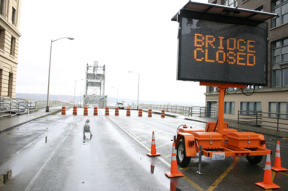Op-Ed by Todd Matthews, Editor
When the Washington State Department of Transportation announced Tuesday it would close the Murray Morgan Bridge to vehicular traffic immediately, citing “life safety concerns” due to the deteriorating state of the 94-year-old, 1,748-foot-long span, it confirmed an unfortunate truth: if you neglect something long enough, it’s hard to argue why it’s worth saving.
It’s true for most things: abandoned and crumpled houses razed for new development; old automobiles piled on front lawns, eventually destined for junk yards; and even a historic bridge that serves as skyline landmark and connection to Tacoma’s rich history.
Yesterday, WSDOT employees entombed the bridge on the east and west ends with concrete barricades, and provided media tours of the bridge’s crumbled condition. As an engineer pointed to exposed rebar on the bridge deck, rusted steel railings, and crushed concrete, his tour was more of an indictment of the state’s failure to maintain the bridge than the danger of sending heavy fire trucks across a rickety structure just because it’s the quickest route to the Port of Tacoma and the area’s industrial tide flats.
Tuesday’s announcement by newly-appointed Secretary of Transportation Paula Hammond rightly infuriated several Tacoma City Councilmembers.
Typically, Councilmember Tom Stenger had the sharpest words. “You understand you put yourself in this position,” Stenger told Hammond. He was referring to something that many councilmembers and Tacomans familiar with the bridge have alleged: the state’s failure to maintain the bridge — not necessarily the age of the bridge alone — led to its closure this week.
Stenger was blunt: “When was the last time you even painted it?”
Mayor Baarsma was equally critical.
“The feeling and belief [among many people] is that it was the DOT’s intention all along to remove the bridge through benign neglect,” he said. He added the state had “a lot of explaining to do over the neglect of that bridge over the last few years.”
Councilmember Julie Anderson echoed her colleagues: “I’m profoundly disappointed in the lack of action that brought us to this day.”
Stenger and Baarsma point to an agreement between the City of Tacoma and WSDOT that they say shows the state had an obligation to maintain the bridge and either return it to the city in good condition, or replace it outright.
The agreement, which the Index obtained yesterday, is dated March 23, 1995, states the “state shall retain ownership and maintenance of the existing Thea Foss Waterway Bridge until the state completes the rehabilitation of the bridge. Upon the completion of the rehabilitation, the city shall accept said [bridge].”
A supplement to the agreement dated Jan. 26, 1998, states, “The state shall retain ownership and maintenance of the existing Murray Morgan Bridge . . . until the state replaces the existing bridge with a new bridge. The new bridge will be either a replica of the existing bridge or of a alternative design developed through a public process including consultation with the Tacoma City Council. Upon completion of the replacement of the existing bridge, the city shall accept said [bridge].”
What was clear Tuesday was the disconnect between the state and the city over the bridge’s importance to emergency service personnel. Why save a 94-year-old bridge when a newer, higher-capacity bridge exists just to the south?
When asked how fire trucks and paramedics would access the industrial tide flats, Hammond pointed to State Route 509, which opened 10 years ago and carries 28,000 vehicles daily (the Murray Morgan Bridge carries 1,300 daily). But several councilmembers argued the SR 509 route would add as much as 20 minutes to a trip from downtown Tacoma to the tide flats furthest reaches.
Councilmember Mike Lonergan furiously demanded the state come up with a speedy route for emergency personnel. “The bridge should not be closed until there is a full plan,” he roared. “Otherwise, we should be asking the governor to declare a state of emergency.”
He said added time associated with the new route across SR 509 could be the difference between life and death for someone suffering a heart attack on the tide flats.
“Now there’s a life safety issue,” he added.
If any “good news” existed Tuesday, it came with its own caveat: $25 million in state funds exist for the bridge; but a new bridge could cost $75 million or more, according to a 2004 recommendation. Why a portion of that money wasn’t used to repair and rehabilitate the bridge beginning in 1997 — when the city and the state started to show concern over the bridge’s condition — is unclear.
This week, the state showed it’s easy to shut a bridge down under the blanket of a ‘life safety concern.’ City Council should show it’s equally easy to hold the state to its original agreement and save the Murray Morgan Bridge.





